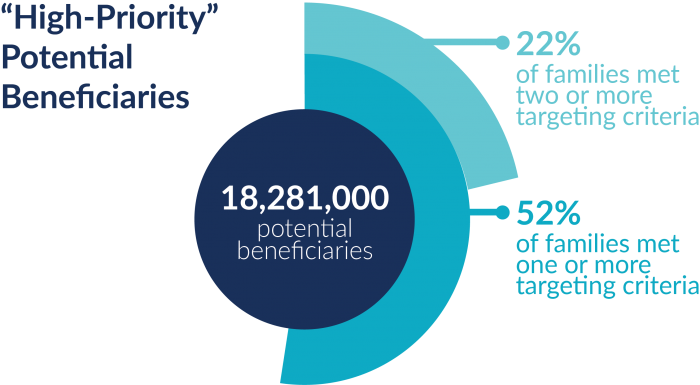
This blog post is the first in our two-part look at home visiting’s current and potential reach. The second post will use geographic data to examine gaps in home visiting services.
Home visiting programs have expanded in geographic reach and in the number of parents and families served. In 2015, more than a quarter of a million families received home visiting services from evidence-based programs in which a trained professional comes to a family’s home to help parents meet goals for themselves and their children. But how many more could benefit?
Under the broadest estimate of potential beneficiaries—that is, families with children not yet in kindergarten and pregnant women who don’t have small children—the answer hovers around 18 million. Seventeen million families fell into that first category in 2015, and an additional 1.3 million women fell into the second.
[Read Chapter 2 of the 2017 Home Visiting Yearbook to learn more about families and children who could benefit from home visiting.]
Targeting Participants to Maximize Resources
Many home visiting programs maximize limited resources by identifying participants who could see the greatest benefit from services:
- Parents of infants—Parents adjusting to life with a newborn or infant might benefit from one home visit, if not two or three, after their baby’s arrival. In 2015, approximately 3.5 million families nationwide had infants under age 1.
- Pregnant teens and young mothers under age 21—Young women who become pregnant as teens face challenges adjusting to both parenthood and adulthood. More than 600,000 women and families fell into this category in 2015.
- Children with a history of maltreatment or prior involvement with the child welfare system—Home visiting programs may reduce maltreatment. Although it is difficult to gauge how many families fall within this category, we know the rate of substantiated child abuse was 9 per 1,000 children under 18 in 2014.
Most programs fall somewhere between serving all infants in a community and focusing on community members who fall within one category. Programs often use multiple targeting criteria.
[Visit the model profiles to explore approaches to providing home visiting services, including target populations.]Finding Common Ground
Home visiting programs use knowledge of local communities to identify families who could benefit from services, which makes it difficult to draw comparisons across locations. To help states consistently identify families with much to gain from home visiting, we defined “high priority” to include families who meet any 1 of 5 targeting criteria:
- Having an infant
- Income below the federal poverty threshold
- Teen pregnancy or mother under 21
- Single (never married) mother or pregnant woman
- Parents without a high school education
We chose these demographic and economic criteria based on their availability through valid data instruments such as the American Community Survey, which does not collect information on substance abuse, child maltreatment, or developmental delays.
Fifty-two percent of pregnant women and families with children not yet in kindergarten—more than 9.5 million total—met at least one of the criteria above, according to our estimates. Twenty-two percent met at least two. The share of families that met two or more ranged from 12 percent in Utah to 30 percent in Mississippi.

[Search the state profiles in the 2017 Home Visiting Yearbook to see what share of potential beneficiaries met one or more of our targeting criteria in your state.]
Whether looking at the broadest swath of potential beneficiaries or focusing on families facing a specific challenge, it’s clear that home visiting has room to grow. Although certain states and programs have succeeded in reaching more children and families, they must continue to expand home visiting’s reach to make a bigger difference for their communities.
This blog post was developed by the Urban Institute and is also available on its website.